USING THE FRESH WATER SYSTEM RAIN HARVESTING & WATER RECYCLING
The Deep Green unit has a fresh water system. Single or twin toilet cubicles are fitted with fresh water microflush toilets and waterless urinals with hot water hand wash units.
The patented Waste Management ProTM system harvests rain water from the roof and uses this in the hand wash units. Grey water from sinks is then recycled to flush toilets.
7
7 USING YOUR FRESH WATER SYSTEM

This welfare cabin is fitted with a unique patented Waste Management ProTM fresh water system which is designed to save water consumption in the cabin and cut waste production.
The cabin roof is designed to capture and harvest rain water [1] which is then channelled from the roof via a series of sieves and particle filters, before being delivered to the fresh water tank beneath the unit. This water is sterilised either by a UV system or by chlorine before being heated and used for hand washing in the Canteen and Toilets.
If not enough rain falls to fill the tank, it may alternatively be filled manually using any other source of fresh clean water.
The grey water recycling system reduces the amount of water needed in the cabin and cuts liquid waste. Water used in the Toilet sinks [2] is funnelled to a grey water holding tank [3] and later utilised to flush the toilets [4]
Other water-saving features are microflush toilets that use 0.5l of water per flush compared to 6l in a standard toilet and a urinal which is completely waterless.
In section 7 of the Manual, we explain how to use the Waste Management ProTM fresh water system and the cabin toilets.
7.1 RAIN HARVESTING
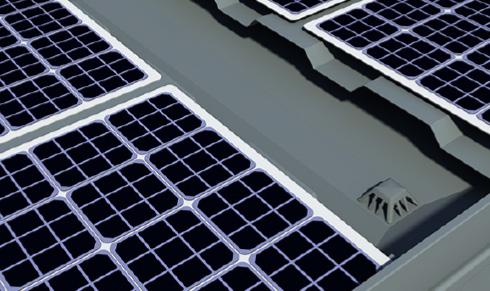
The roof of the cabin is designed to direct rain water to a funnelling point which channels water down into a tank in the base of the cabin.
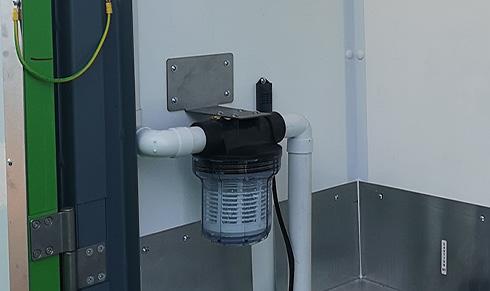
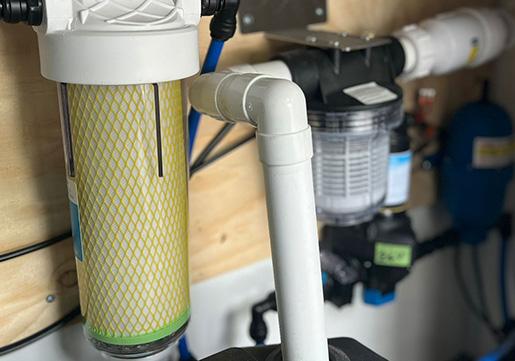
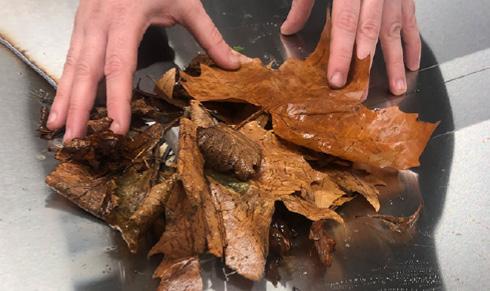
Dependent on cabin location and weather conditions, the rain water sieve drain should be checked regularly for obstructions such as fallen leaves or other debris. Clear any obstructions immediately and dispose of them.
IMPORTANT
When washing the solar panels or roof of the cabin, the red valve must be closed to prevent dirty washing water entering the water tank. This water will then be redirected and run away to the ground beneath the cabin.
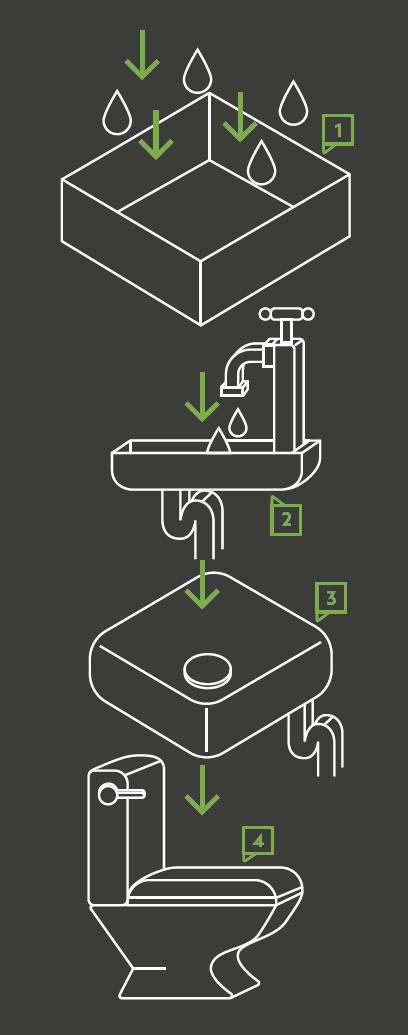
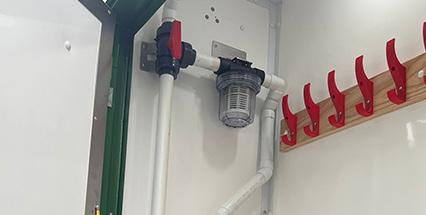
After passing through the roof sieve, rain water is directed through a fine particle filter [1] to remove any material items. This filter will either be found in the drying room or toilet cubicle. A second particle filter [2] is installed to sieve the water again when it passes out of the fresh water tank before moving through the sterilisation system. This is located under the office desk (20ft and 24ft units) or under the sink in the toilet (12ft and 16ft units). Both particle filters should be checked and washed out at regular intervals. We recommend every 6 months or earlier if any blockage is noted.
7 – Using Your Fresh Water System
1 2 40
7.2 WATER STERILISATION
Depending on the model and age of your Deep Green unit, it will have one or more of the following water sterilisation systems.
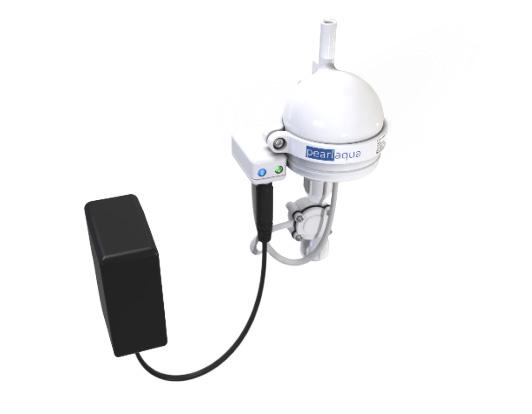
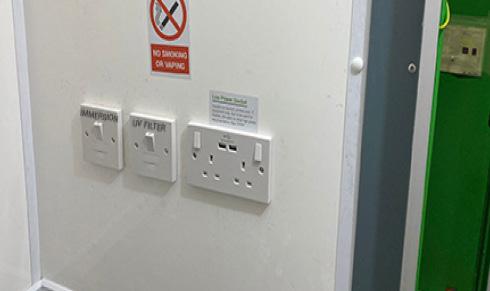


Type A - LED UV sterilisation. If your cabin is fitted with an LED UV sterilisation unit, this functions completely automatically once the Hibernation Switch in ON and you do not need to turn on an isolator. This sterilises all water passing from the fresh water tank to the hand wash units. NOTE: The bulbs in the LED unit do not need checking or changing.
Type B - Non-LED UV sterilisation. If your cabin has a non-LED sterilisation system there will be an isolator in the Office (20ft and 24ft), or it will be located under one of the benches towards the rear of the canteen (12ft and 16ft). This should be turned on at all times when water might be used. The Hibernation Switch will also need to be on. This UV unit sterilises all water passing from the fresh water tank to the hand wash units. NOTE: If the UV bulb fails, the unit will emit a beeping sound and the green light on the unit will turn off. To change the bulb, you must consult the manufacturer’s instructions. Do not open the UV unit before reading the instructions.
Type C - Chlorine sterilisation. In units fitted with a chlorine sterilisation system you will see a chlorine tab entry point. In 20ft and 24ft units, this will generally be located in the Drying Room. Otherwise, it will be in one of the toilets. The chlorine tab should be checked daily and a new tab inserted once the previous one has disappeared. Generally tabs will last an average of 6-8 weeks if rain is entering the system every day, longer if not.
Type D - Micron sterilisation filter. This sterilises water passing betweeen the fresh water tank and the hot wash units. These filters are located under the desk in the office in the 20ft and 24ft units. In the 12ft and 16ft units, they are located under the sinks in the toilets. The micron filter cartridge should be changed every 12 months. For more details, refer to the manufacturer’s instructions.
41 7 – Using Your Fresh Water System
7.3 FRESH WATER TANK
CAUTION
12ft, 20ft and 24ft Deep Green welfare cabins are designed so that they may be towed with a full tank of water so it is not necessary to empty the fresh water tank prior to transporting. However, do not attempt to tow the 16ft Deep Green unit with a full water tank as it may become unstable. Always empty the fresh water tank before towing.
SOLARTrackTM
All tank levels in Deep Green cabins can be remotely monitored by authorised users via the online SOLARTrackTM system. Contact your cabin provider to see if you have access to this system and for instructions on how to use it.
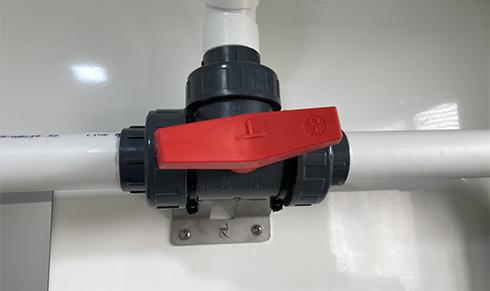
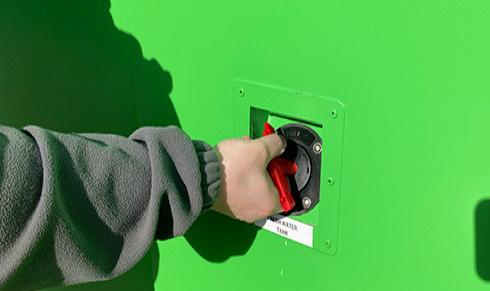
Fresh water for the hand wash units is stored in a tank in the base of the cabin. This is filled in two ways.
1) Via the rain water harvesting system.
2) The tank can also be topped up via the black filler cap on the side of the unit. To undo the filler cap, use the tool provided. Always fill with clean fresh water.
CAUTION
It is important to never let the water tank run dry as otherwise, damage may be caused to the water heater.
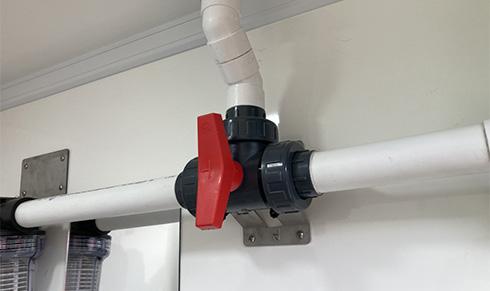
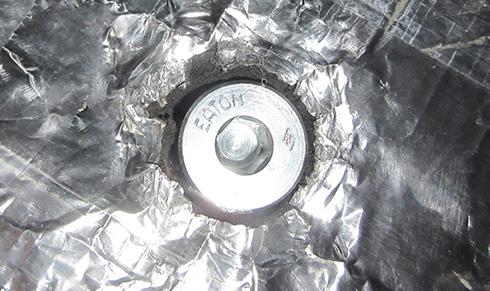
It is essential to drain the fresh water tank of a 16ft Deep Green unit before towing. To empty the fresh water tank in either a 16ft or 12ft unit, locate the drain for the clean water tank on the underside of the trailer. Use a suitable tool to remove the drain plug from the tank. Make sure the cabin is in a suitable place to allow the water to run away or use a container to catch the water then dispose of it. Replace the drain plug.

To empty the fresh water tank in a 20ft or 24ft unit, locate valve for the tank drain inside the cupboard under the desk in the Office. When you open the rainwater tank drain valve, water from the tank will run out from an outlet beneath the cabin. Make sure the cabin is in a suitable place to allow the water to run away or use a container to catch the water then dispose of it. Close the valve after emptying.
If you ever want to stop rain water entering the fresh water tank (for roof cleaning purposes etc.), locate the red rain water valve in either Drying Room or Toilet. Turn it to the correct position so water from the roof is prevented from entering the tank and instead flows through the downpipe away to the ground beneath the cabin. When finished, remember to turn the valve back to allow rain water to again enter the tank.
7.4 GREY WATER RECYCLING
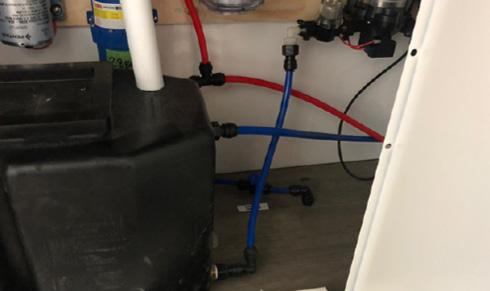
After water is used in the toilet sinks, it flows away into a grey water holding tank. It is stored there until required for flushing the toilets.
There is a grey water filter found near the grey water tank. It should be checked regularly and cleaned at 6 month intervals. The grey water tank in the 24ft unit is found in a cupboard under the desk in the office. In the 12ft and 16ft units, the grey water tank is found under the bench seat in the canteen.
7 – Using Your Fresh Water System
42
7.5 WASTE
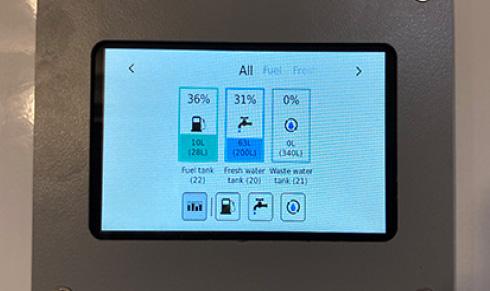
It is important to check the waste tank level in your cabin regularly. To do that, use the digital gauges located in the Canteen. If nothing is showing on the panel, make sure the Hibernation Switch is ON. The gauge panel will then light up and display Fresh Water, Waste and Fuel tank level information.
The waste tank level can also be checked remotely using the SOLARTrackTM system.
7.6 TOILET
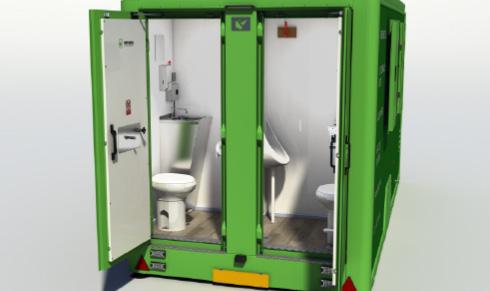
Your cabin is equipped with female and male toilet cubicles. Each contains a fresh water micro flush toilet. The male cubicle also contains a waterless urinal.
TANK AND DISPOSAL

When more than 3/4 full or before towing, any waste in the waste water tank must be removed. The waste water is pumped out from the outlet located inside the toilet compartment in the floor. Remove the cover using the tool provided. Connect the equipment to the drain and remove the waste. If you experience any issues with solid waste build up in the tank, you may also insert the waste extraction pipe directly down the toilet to access solid waste below the outlet. Replace the cover.
CAUTION
The waste water tank contains biological and chemical waste from the toilet and should only be removed by suitably trained personnel using specialist equipment. It is an offence to discharge waste into surface or domestic drainage systems.
CAUTION
The unit should never be towed with water in the toilet waste reservoir as this may cause it to become unstable and overweight. Always make sure the tank is drained by a specialist company before towing the unit.
SOLARTrackTM
All tank levels in Deep Green cabins can be remotely monitored by authorised users via the online SOLARTrackTM system. Contact your cabin provider to see if you have access to this system and for instructions on how to use it.
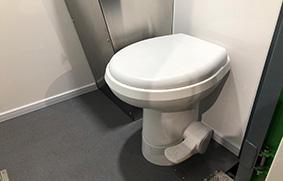
To flush after use, press down the foot pedal for a maximum of 5 seconds to clear the bowl.
NOTE: This is a MICRO FLUSH toilet designed to use significantly less water than a traditional toilet. Approx 0.5l per flush rather than 6l in a standard toilet.
7.7 HAND WASH
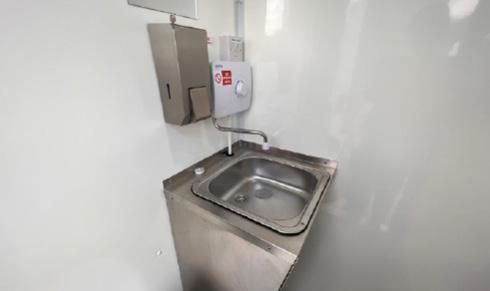
BASIN
IMPORTANT:
Only toilet paper should be flushed down this toilet. Do NOT try to flush hand towels or any other sanitary products in the toilet.
The toilet cubicles are fitted with stainless steel sink basins. Hot water for hand washing is supplied via instant hot wash units. To start the unit, simply turn the dial to the required temperature. The water is heated instantly and starts to flow. The temperature of the water can be controlled by turning the dial from 1 – Cool to 10 – Hot.
If no water comes out of the tap, check there is water in the fresh water tank. See 7.2 for how to check and fill the fresh water tank.
If the water comes out of the tap cold, check that the instant hot water unit isolator is ON. This is located just above the unit.
CAUTION
To avoid scalding set the water temperature to cool at start of use and gradually increase as required. Allow the water to run for a few seconds before use.
7 – Using Your Fresh Water System
43
7.8 HAND DRYERS
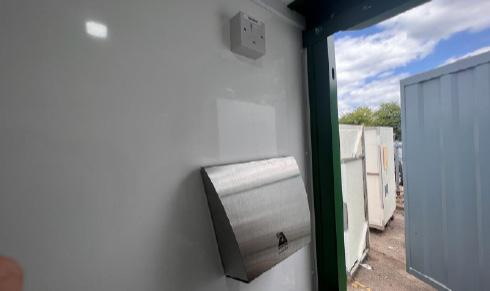
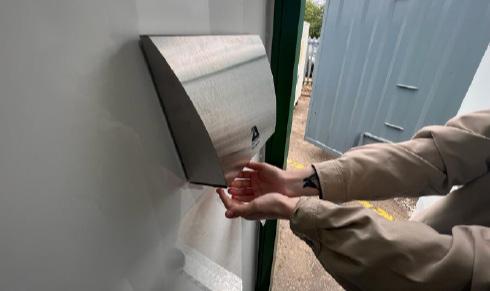
7.9 SOAP DISPENSER
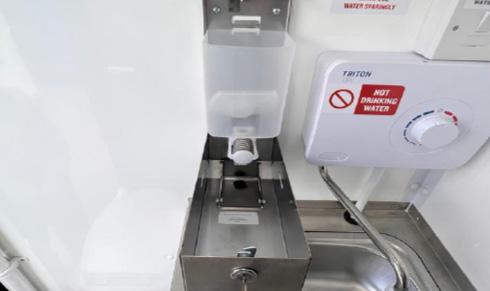
Toilet cubicles are fitted with low-power hands-free electric hand dryers for hygiene and convenience. To operate the hand dryer, simply place your hands beneath the air outlet and hot air will flow. The hand dryer isolator [1] must be in the ON position for the hand dryer to function.
The toilet cubicle is fitted as standard with soap dispensers in each toilet and in the canteen. To fill your dispensers, use the key provided to open the dispenser and drop the front down. Refill the soap container, close and relock.
7.10 TOILET DOOR LOCKS
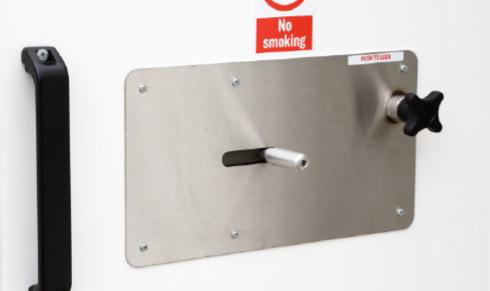

To lock the door from inside the toilet cubicle, first use the handle to close the door firmly. Next move the slider fully to the left, then push in the plunger to lock.
To unlock, pull the plunger out and move slider fully to the right. Use handle to push the door open.
There are safety locks on the toilet doors which means that as well as the usual internal lock, there is an external key-operated lock to allow access in case of an emergency.
Emergency Unlocking Procedure:
From outside the toilet cubicle, use the key to unlock the door. This will release the plunger. Move slider to the right and this will release the door.
7 – Using Your Fresh Water System
44
1


























